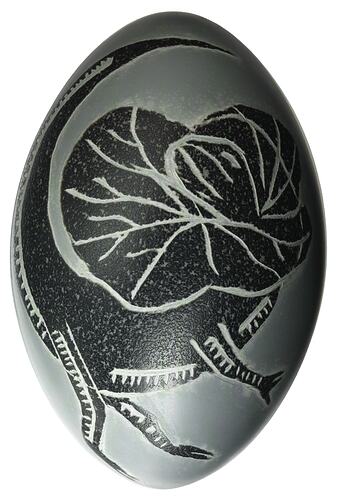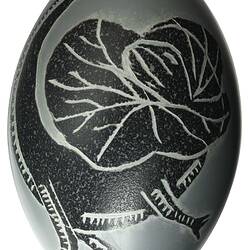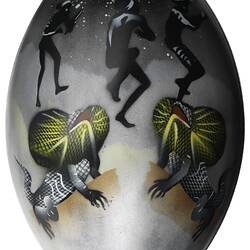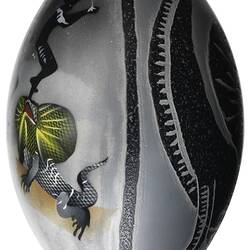Summary
Keith Morgan and his family reside in East Gippsland, Victoria, where they once earned their living picking seasonal fruit. During his work breaks in the paddocks, Keith would carve emu eggs. His son Adrian (also known as Ringo) observed him and instantly became interested in the craft, and is now also a prolific and renowned carver.
Keith's designs typically incorporated lizards, kangaroos and emus, with the decoration on this particular emu egg featuring a combination of a single carved frill-neck lizard on one side and two painted lizards underneath three men dancing under a full moon on the opposite side.
Local Name
Kalti paarti
Physical Description
Emu egg. Incised design on one half, the other half is painted. Carved half has a frill-necked lizard. Painted side has two lizards and three men and the moon. Painted black, white, yellow, red and orange.
Significance
Kalthi-parti (emu-egg) carving first became popular in the mid to late 19th century. The practice continues today through the skill of several Aboriginal egg carvers from south-eastern Australia and the Carnarvon region of Western Australia. Artists depict significant animals, peoples, traditions and scenes from cultural life of the past and present, forming a rich visual history that reinforces connections to Country.
In June 2010 Meriam Mir/Ku Ku artist and curator Clinton Nain presented an exhibition of carved emu eggs at Craft Victoria which featured work by Keith's son, Adrian 'Ringo' Morgan. Explaining the relatively recent use of emu eggs to tell stories in Aboriginal culture, Nain explains;
'Denied traditional forms of cultural expression, Indigenous communities adopted the emu egg as a medium to tell stories, explain totems and reveal knowledge of land, place and identity.strengthening and retaining links to the past.' Clinton Nain 2010.
References
Henry F. Skerritt, Carved out of Life: the Art of Emu Egg Carving, 2010, Viewed 16 August 2017.
https://henryfskerritt.com/tag/carved-out-of-life/
More Information
-
Object/Medium
Carving
-
Maker
-
Locality
-
Date Produced
-
Object Measurements
255 mm (Length), 125 mm (Width), 80 mm (Height)
-
Classification
-
Date Made
-
Maker
-
Clan/Language Group
-
Place Made
-
Indigenous Region
-
Keywords
-
Type of item
-
Discipline
-
Category
-
Collecting Areas





